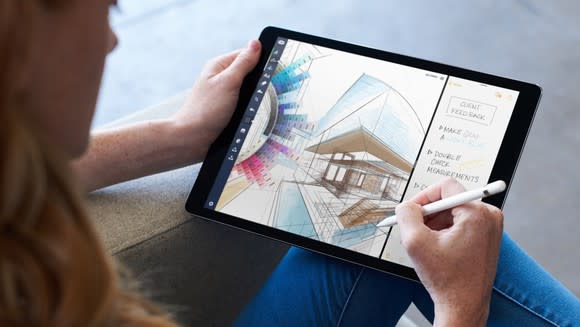3 Reasons to Buy Apple Inc.'s 10.5-Inch iPad Pro Instead of the New 9.7-Inch iPad
On March 27, Apple (NASDAQ: AAPL) introduced an updated version of its highly successful low-cost 9.7-inch iPad, known simply as "iPad." The improvements included a new processor and support for the company's Apple Pencil accessory.
Previously, support for the Apple Pencil was a feature limited to the company's higher-end iPad Pro product line. By adding Apple Pencil support to the lower-cost iPad, Apple just took away a major selling point that its higher-end iPad Pro models enjoyed.

Image source: Apple.
Here's the good news for investors, though: The iPad Pro tablets are still so significantly differentiated from the low-cost iPad that it's unlikely that somebody interested in the iPad Pro for any reason beyond Apple Pencil support would go for the cheaper iPad instead.
Let's go over three ways the iPad Pro is still superior to the new low-cost iPad.
1. ProMotion display
Apple's higher-end iPad Pro tablets include a display feature that Apple dubs ProMotion. In a nutshell, ProMotion displays update their contents at a rate of up to 120 times per second, while non-ProMotion displays only update at 60 times per second.
The faster displays on the iPad Pro tablets make a huge difference in everyday usage, as just about everything -- particularly swiping and scrolling -- feels a lot faster and more fluid.
I suspect that Apple will continue to differentiate its iPad Pro line with faster displays than their more mainstream counterparts in the years ahead.
2. More colorful display
Over the last several years, Apple has been upgrading the displays across its various devices (Mac, iPhone, and iPad Pro) to support a wider color gamut known as DCI-P3. Here's what Apple's developer documentation says about DCI-P3:
Wide color displays support a P3 color space, which can produce richer, more saturated colors than sRGB. As a result, photos and videos that use wide color are more lifelike, and visual data and status indicators that use wide color are more impactful.
Wide color displays are supported by the original 9.7-inch iPad Pro, the current 10.5-inch and 12.9-inch iPad Pro models, and iPhones beginning with the iPhone 7-series. But they aren't supported by the low-cost iPad introduced last year, or its newly announced successor.
So, in addition to having faster displays, Apple's iPad Pro line also comes with more vivid displays than the one on the new iPad.
3. Faster processor
The new low-cost iPad has an A10 Fusion chip inside -- the very same processor that powers the iPhone 7-series smartphones. While it's quite fast overall, Apple's latest iPad Pro has a much faster chip known as the A10X Fusion.
The A10X has six processor cores, compared to the four inside of the Apple A10, and the former has a substantially faster graphics processor than the latter. This means that the higher-end iPad Pro tablets should be superior to the new low-cost iPad in computationally heavy applications, multitasking performance, and 3D gaming performance.
Moreover, while Apple is unlikely to update the low-cost iPad for another year, Apple is probably going to update the iPad Pro line within the next quarter or two. This should allow the iPad Pro line to pull even further ahead of the low-cost iPad in terms of processing power.
More From The Motley Fool
Ashraf Eassa has no position in any of the stocks mentioned. The Motley Fool owns shares of and recommends Apple. The Motley Fool has the following options: long January 2020 $150 calls on Apple and short January 2020 $155 calls on Apple. The Motley Fool has a disclosure policy.
